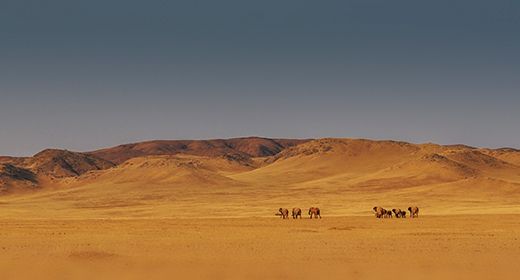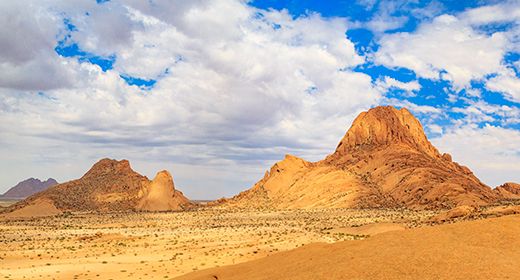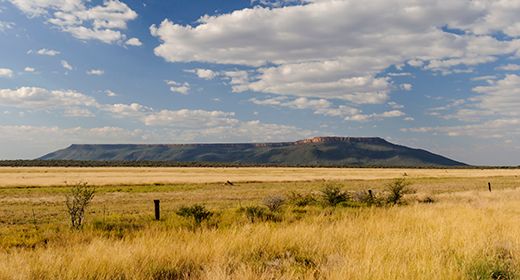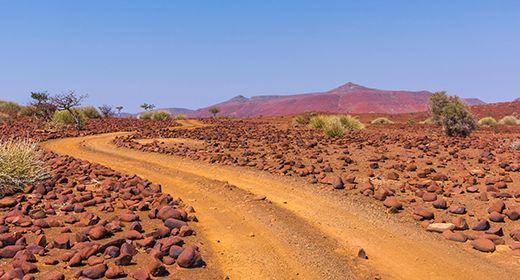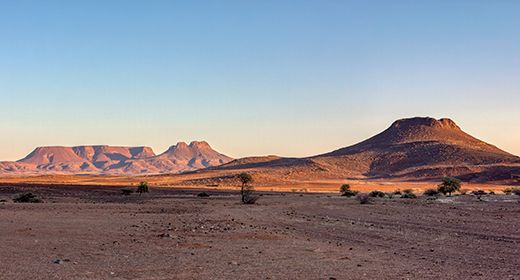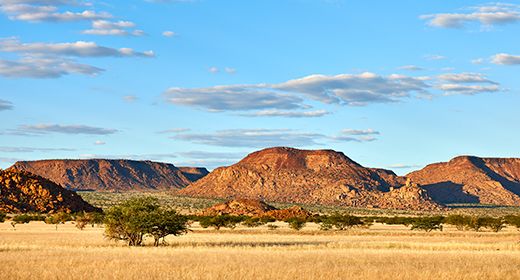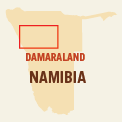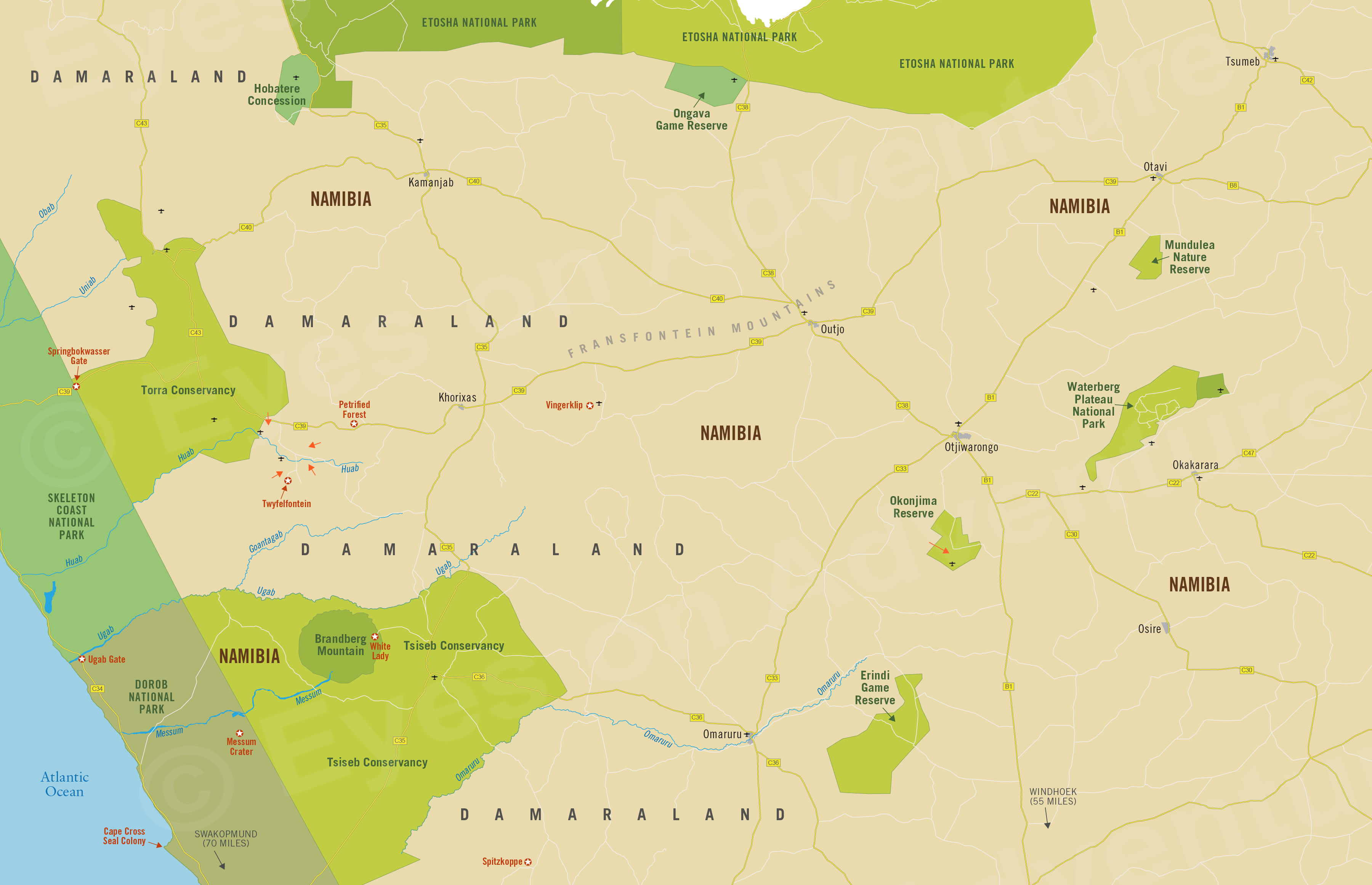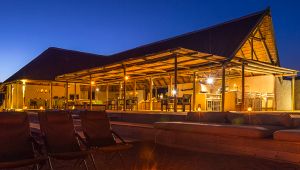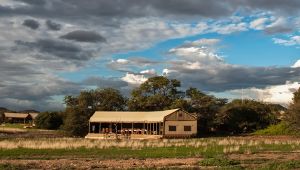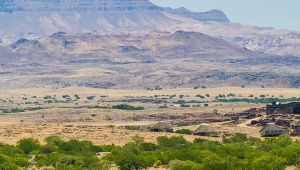Damaraland & Waterberg
(incl. Torra Conservancy, Waterberg Plateau, Okonjima)
Region Links: Caprivi / Zambezi, Damaraland & Waterberg, Etosha, Namib Desert & Sossusvlei, Skeleton Coast, Kaokoland & Kunene, Swakopmund, Windhoek
Highlights
- Northern Damaraland has some of Namibia's best wildlife viewing in a spectacular setting
- Southern Damararaland offers dramatic mountains, rock formations, and Bushman rock art
- Explore Twyfelfontein and the world's largest outdoor gallery of ancient rock engravings
- Explore the Waterberg Plateau National Park for hiking and diverse wildlife
- Stay at Okonjima and participate in the AfriCat Foundation's conservation efforts
EOA Recommends: Damaraland Camp, Desert Rhino Camp, Doro Nawas Camp, Okonjima Bush Camp & AfriCat
Damaraland, so named for the indigenous people, is a place of magnificent landscapes with desert mountains, valleys, red rock inselbergs, wind-blown hills, prehistoric rock art, and desert-adapted wildlife, trees and other plants.
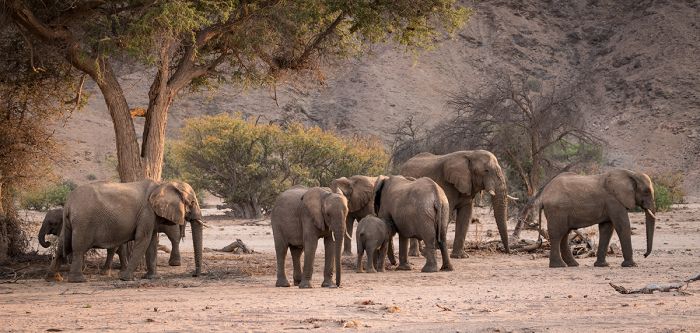
Desert-adapted elephants gather in the Huab riverbed in Damaraland.
Northern Damaraland and the Torra Conservancy comprise one of Namibia's best wildlife viewing destinations. The region supports desert-adapted elephants and lions, black rhinos, gemsbok (oryx), Hartmann's mountain zebra, giraffe, springbok, jackal, caracal, brown hyena, and more. There are numerous accommodations to choose from in the region.
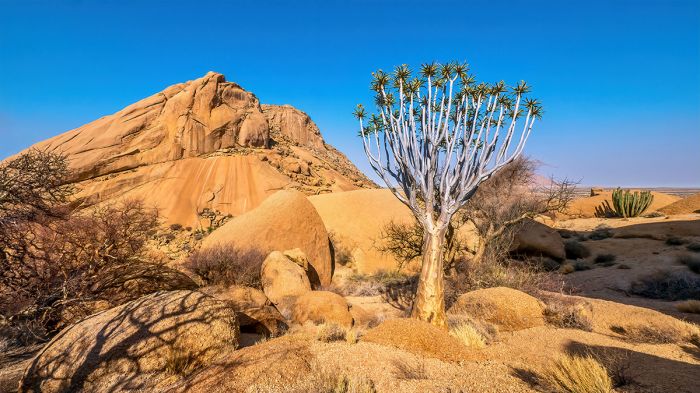
Dramatic landscape at Spitzkoppe with granite boulders and a quiver tree.
Southern Damaraland is known for its mountains and very accessible Bushman rock art sites. Spitzkoppe is a cluster of mountains containing rock art sites and Brandberg Mountain contains the famous White Lady of Brandberg rock paintings. Twyfelfontein has hundreds of engravings and rock paintings and is Namibia's first UNESCO World Heritage Site.
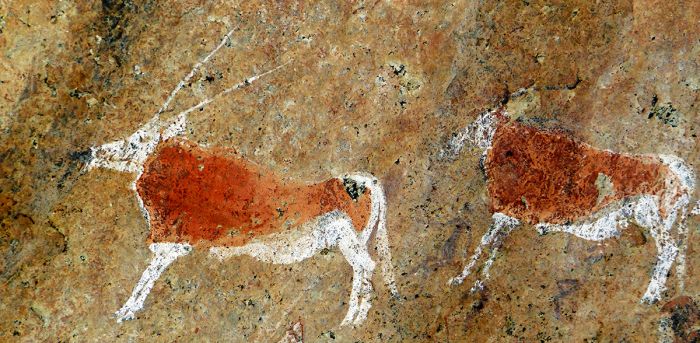
Bushman rock art at Brandberg Mountain in southern Damaraland.
East of Damaraland are two other excellent destinations: Okonjima and the Waterberg Plateau.
Okonjima is home to the well-known AfriCat Foundation, which is a long-running conservation initiative to protect Namibia's cheetahs, leopards and other large carnivores. Guests staying at Okonjima are offered a chance to participate in various ways during their stay.
The Waterberg Plateau is a massive sandstone plateau that towers above the desert plain. The national park that protects this region offers a large diversity of wildlife and some good safari camps.
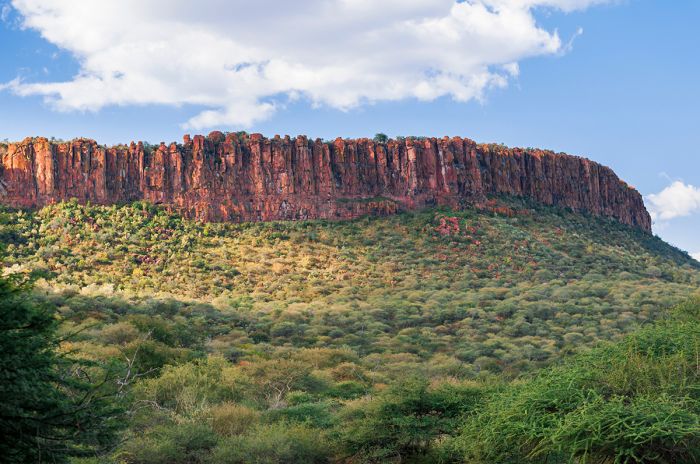
A portion of the Waterberg Plateau in Namibia.
Read More...
AfriCat, Brandberg Mountain, Damaraland, Erindi Reserve, Mundulea Reserve, Northern Damaraland, Southern Damaraland, Spitzkoppe, Twyfelfontein, Waterberg Plateau, Okonjima
Damaraland
The Damaraland region lies directly inland from the Skeleton Coast and Dorob National Park and south of Kaokoland in northern Namibia. The region is defined by rugged, rock-strewn landscapes, interspersed with mountains and inselbergs, lava fields, red rock formations, ancient rock art, and several rivers, which are almost always dry above ground.
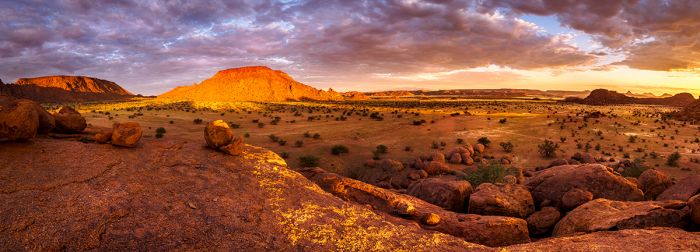
Sunset and Damaraland landscape near Twyfelfontein.
Damaraland is best defined as two distinct sub-regions: Northern Damaraland, which is less accessible (4WD or fly-in) and offers the best wildlife viewing; and Southern Damaraland, which is known for its accessibility (self-drive and 2WD), rock art sites, and geological points of interest.
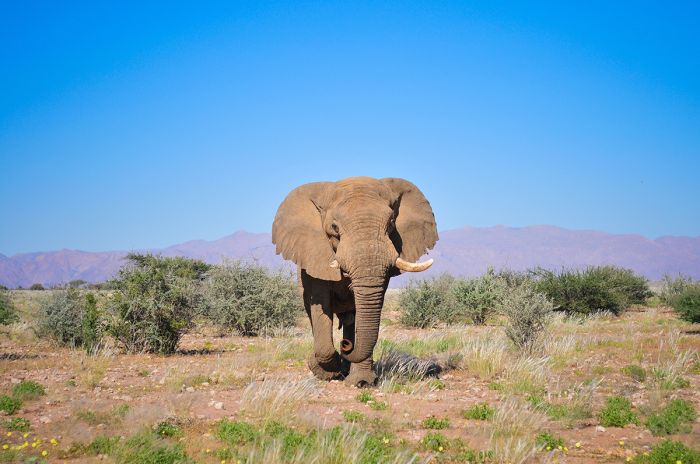
Bull elephant with Brandberg Mountain in the distance.
Northern Damaraland
Northern Damaraland is a dry place, with extremely low rainfall and where only specially adapted plants and animals are able to survive. This is a desert region - not one of sand, but rather a harsh and rugged landscape with massive lava fields, gravelly sediment-covered hills and valleys strewn with granitic rocks and boulders, and brilliant red rock formations. Geologic movement over millions of years have created the countless stones and sediments upon which only sparse grasses, desert scrub, and desert-adapted trees can grow.
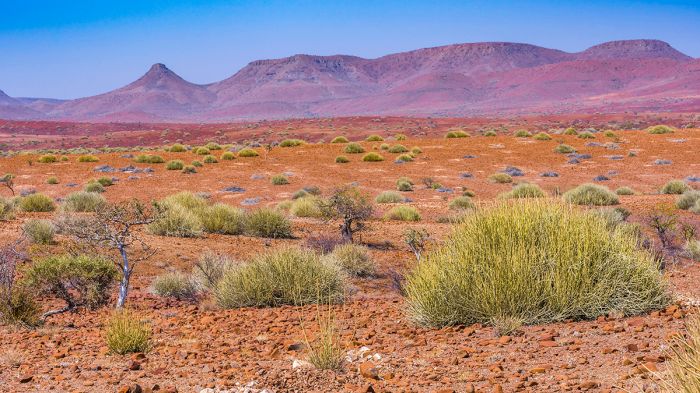
Landscape showing Damara milk bushes and shepherd's trees in the Palmwag area.
The shepherd's tree and the spiky Damara milk bush (Euphorbia damarana) are abundant here. The milk bush is poisonous to all except for the black rhino and greater kudu, which can eat them. Another notable plant found across the region is the Welwitschia mirabilis, a species that lives upwards of a thousand years!
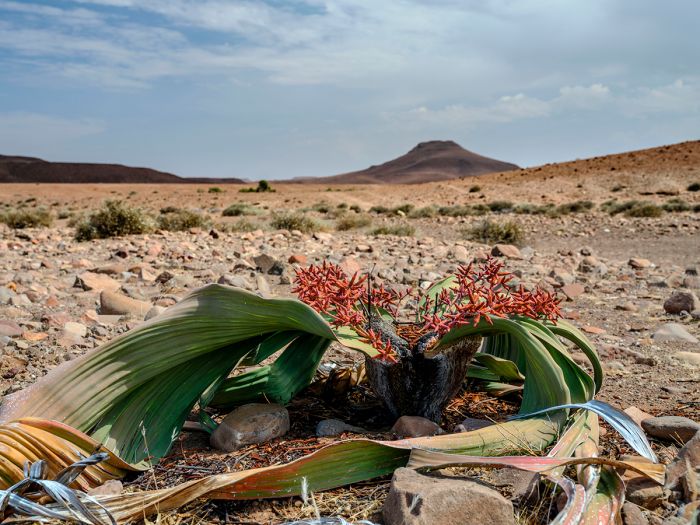
The interesting Welwitschia mirabilis plant can live over 1,000 years.
The rivers, especially the Huab, are the best places to search for wildlife. The usually dry Huab riverbed provides an oasis of life, with underground water that supports a fertile vein of life in this desert land. Elephants can often be seen feeding on the seed pods of the Ana trees (Faidherbia albida) that grow along the river. The elephants also dig in the dry river for underground water, creating large drinking 'wells' that provides a drink for numerous other animals and birds that visit after the elephants move on.
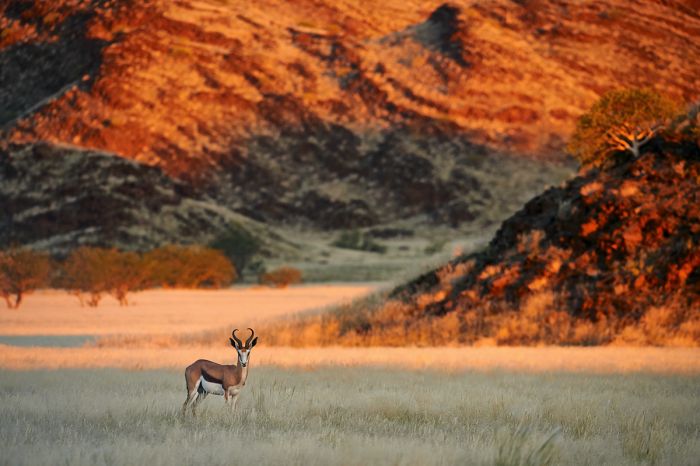
A springbok in Northern Damaraland.
The northern part of Damaraland has several land concessions that have been set aside for use by the tourism industry, which typically includes agreements with the local communities to partake in the operations.
The Torra Conservancy has Damaraland's best wildlife viewing. Various safari camps here offer superb experiences for their guests. The local people are allowed to live and keep their livestock within the tourism areas, but development is very limited. Tourism concessions here include Palmwag, Etendeka, Damaraland/Desert Rhino, Hobatere (adjacent to western Etosha), and Huab Lodge.
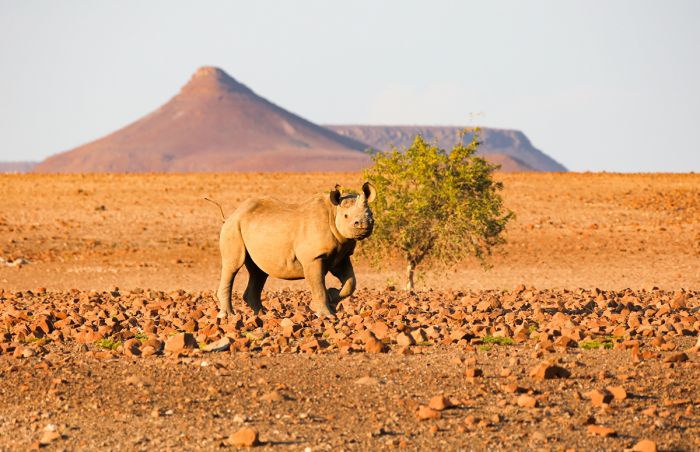
A black rhino at Desert Rhino Camp in Northern Damaraland.
Besides for the desert-adapted elephants, the region also supports the endangered black rhino, which can be tracked at Desert Rhino Camp. Leopards live in the hills and along the rivers, and lion and cheetah are occasionally seen. Other species living in the region include giraffe, Hartmann's mountain zebra, oryx, springbok, greater kudu, chacma baboon, steenbok, warthog, and klipspringer.
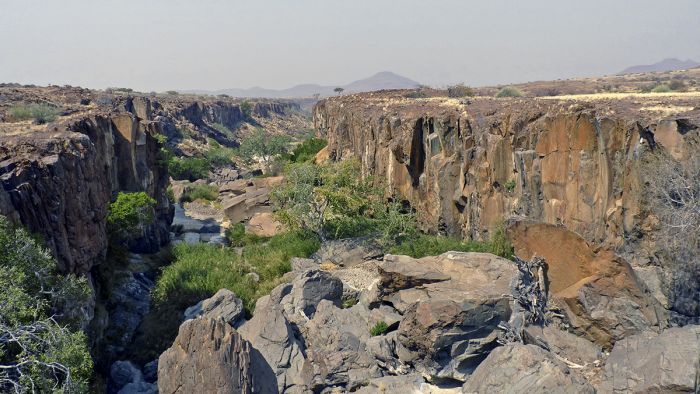
Dramatic canyon in the Torra Conservancy, Northern Damaraland.
As one moves further to the east from Torra towards Huab and north towards Hobatere, there is more vegetation and thus more wildlife, including the black-faced impala, eland, and the endemic Damara dik-dik, a tiny little antelope. Elephants are more common as well.
Birdlife is mainly comprised of drylands species, including Rüppell's bustard, Monteiro's hornbill, and Herero chat. Raptors such as Verreaux's eagle can be seen soaring over the hillsides.
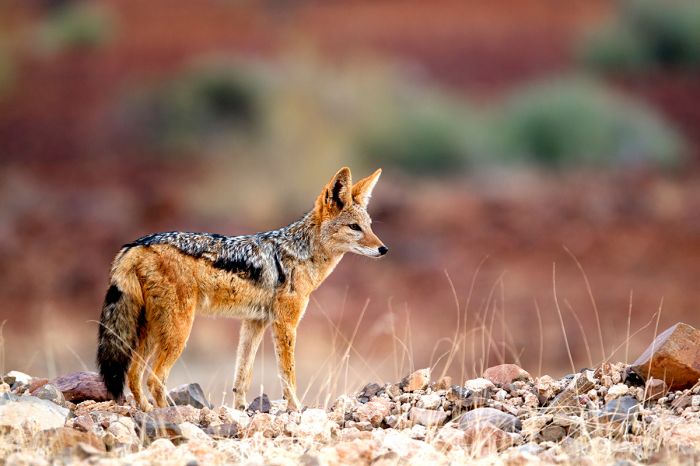
A black-backed jackal in the Torra Conservancy, Northern Damaraland.
Southern Damaraland
Southern Damaraland is a place defined more by its scenery than wildlife and is best known for its mountains, dramatic rock formations, and Bushman rock art sites.
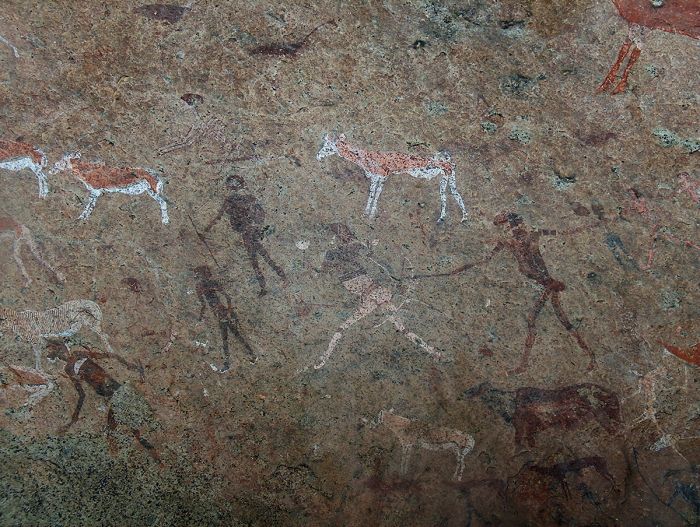
The White Lady of Brandberg rock art painting.
Spitzkoppe is a group of bare granitic inselbergs that date back 120 million years are the site is sometimes referred to as Namibia's Matterhorn. Its highest outcrop rises 5 800 feet (1 765 meters) above the desert floor. Numerous dramatic rock formations, including the Golden Snake and the Bridge are found at Spitzkoppe. Over thirty examples of Bushman cave paintings have been discovered around Spitzkoppe, many of them at Bushman's Paradise.
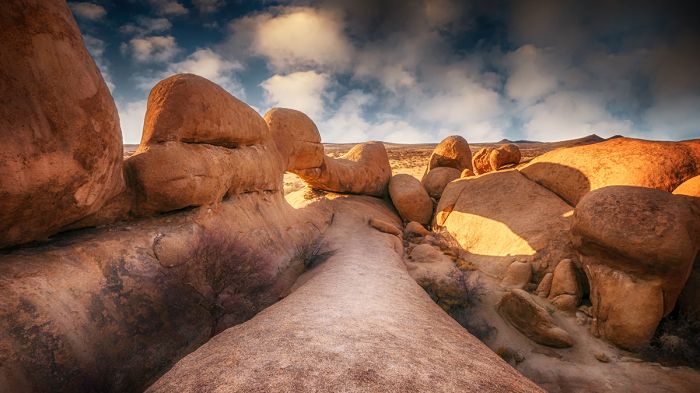
Interesting rock formations at Spitzkoppe in Southern Damaraland.
Brandberg Mountain is a dome-shaped, granitic massif and Namibia's tallest peak, towering 8 442 feet (2 573 meters) over the surrounding plain and covering an area of 250 square miles (650 sq kms). The mountain was apparently a place of great spiritual significance to the ancient people who lived here, as there are spectacular rock paintings here, including the famous "White Lady" painting at Tsisab Gorge. Thousands of rock paintings have been discovered on Brandberg Mountain and it is one of the world's richest galleries of prehistoric rock paintings.
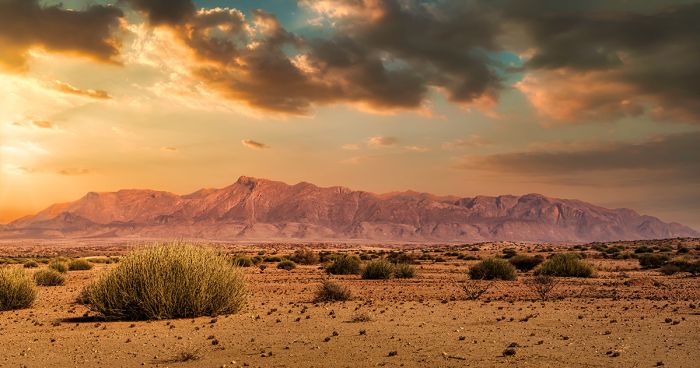
Brandberg Mountain in Southern Damaraland, Namibia.
Twyfelfontein is Namibia's first UNESCO World Heritage Site and the region's most popular tourist attraction. It is the world's largest outdoor rock art site, with thousands of rock engravings on boulders scattered around the site. It is thought that ancient hunter-gatherers lived in the area starting around 6 000 years ago and that the site was used as a place of worship and where shamans conducted rituals. A guided full-day tour is the best way to experience the site.
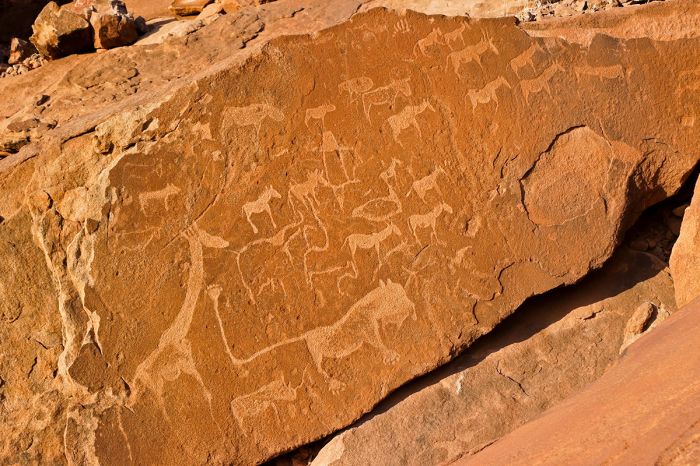
Bushman rock engravings at Twyfelfontein in Damaraland, Namibia.
Other sites of interest include Messum Crater, the remains of an ancient volcano spanning 13 miles (22 kms) across, the Petrified Forest, where trees thought to have died 250 million years ago lie forever in a bed of sandstone, and Vingerklip (rock finger), a dramatic rock obelisk protruding from the flat desert floor.
Southern Damaraland contains some beautiful and alien-looking native flora, especially euphorbias and aloes.
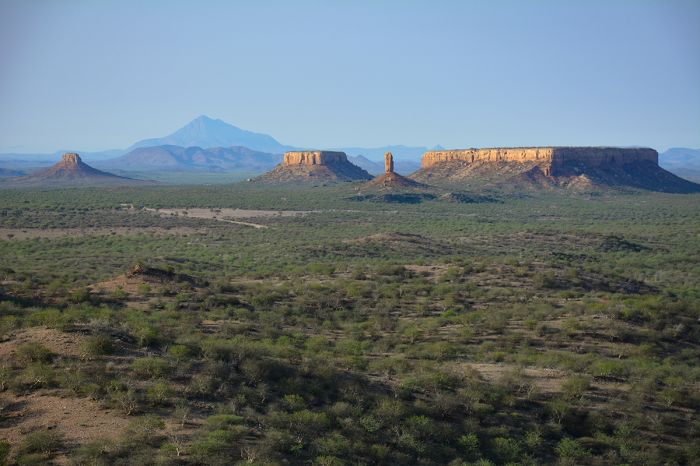
The Ugab Terraces and Vingerklip in Damaraland.
Waterberg Plateau
The Waterberg Plateau National Park offers excellent hiking and a good variety of wildlife, though it is not a game-viewing destination on a par with Etosha. The sandstone plateau and national park are 30 miles (50 kms) long and 10 miles (16 kms) wide and rises 820 feet (250 meters) above the surrounding plains.
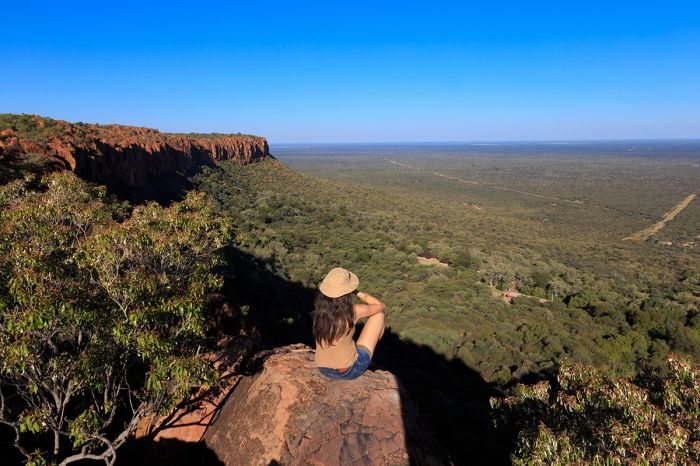
View from atop the Waterberg Plateau.
The park was established in 1972 when numerous endangered species were introduced, including roan and sable antelopes, eland, buffalo, both black and white rhinos, cheetahs, spotted hyenas, giraffes, and more. Besides the rare and endangered wildlife protected here, over 200 species of birds have been recorded here.
There are several lodges that focus their activities, including game drives and walking safaris, in and around the national park.
The Waterberg is also a great destination for hiking. There are two organized, multi-day hiking options in the park. The well-marked Waterberg Unguided Trail covers 26 miles (42 kms), with one departure per week from the Waterberg Rest Camp. The Waterberg Wilderness Trail is a 3-day hike with guides and no set route. There are also various short hikes that can be done in less than a day.
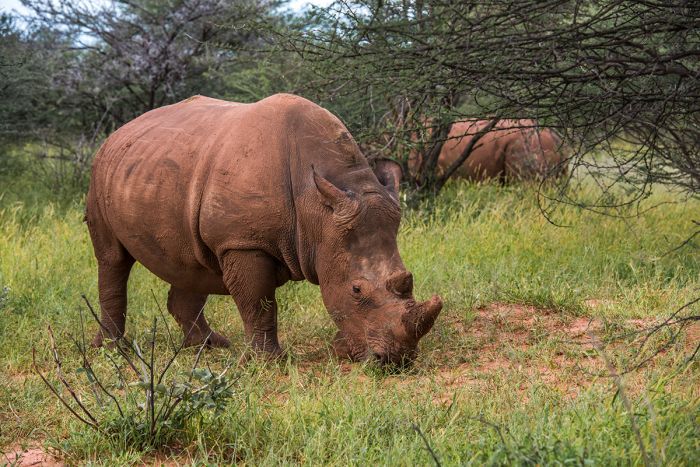
White rhinos in the Waterberg Plateau National Park, Namibia.
Okonjima & AfriCat
The Okonjima Nature Reserve is home to one of Namibia's best known conservation organization, the AfriCat Foundation. The Hanssen family originally farmed cattle here but changed their life focus from farming to wildlife and nature conservation. In 1991, they started the AfriCat Foundation to protect Namibia's native carnivores, including cheetahs, leopards, and brown hyenas. Okonjima offers guest accommodations and a variety of activities concentrating on education and conservation.
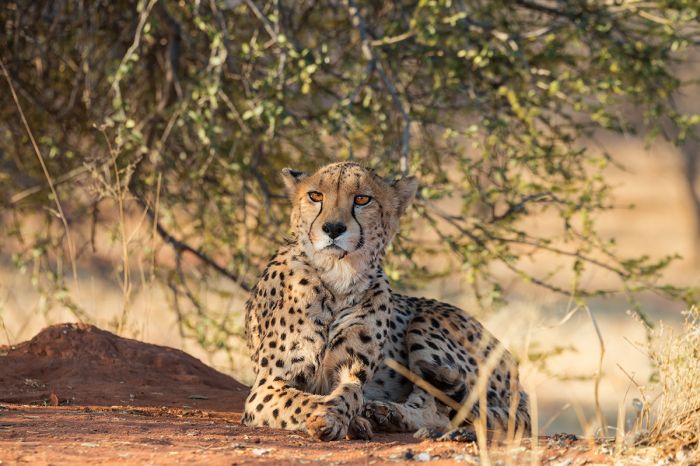
A cheetah in the Okonjima Nature Reserve, Namibia.
Erindi Reserve
Located just south of Okonjima, Erindi Private Game Reserve covers 273 sq miles (707 sq kms) of savanna grassland and mountains. The reserve contains diverse and abundant wildlife including elephant, giraffe, black rhino, lion, leopard, cheetah, wild dog, eland, Hartmann's mountain zebra, springbok, greater kudu, oryx, impala, hippo, crocodile, and more. Many of the predators are collared as there are numerous research projects underway in the reserve.
Accommodation includes a lodge, self-catering chalets, and luxury campsites. Activities offered include game drives, walks, rock art excursions, and visits to a San village.
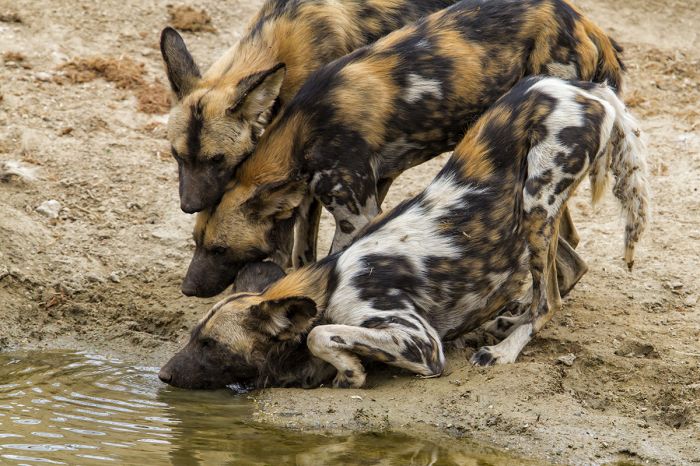
African wild dogs in the Erindi Game Reserve, Namibia.
Mundulea Reserve
The Mundulea Nature Reserve is located in the Otavi Mountains, covering 46 sq miles (120 sq kms) of montane bushland. The reserve has reestablished viable populations of indigenous species that had been hunted to very small numbers.
Species at Mundulea include greater kudu, springbok, roan antelope, red hartebeest, oryx, blue wildebeest, steenbok, warthog, giraffe, black-faced impala, tsessebe, and Hartmann's mountain zebra. Predators include cheetah, spotted hyena, black-backed jackal, serval, caracal, honey badger, and other small carnivores. The birding is very good.
A small bush camp offers tented accommodation, game drives and walking safaris.
Read More...
AfriCat, Brandberg Mountain, Damaraland, Erindi Reserve, Mundulea Reserve, Northern Damaraland, Southern Damaraland, Spitzkoppe, Twyfelfontein, Waterberg Plateau, Okonjima
Great Good Fair Poor
- Jan
- Feb
- Mar
- Apr
- May
- Jun
- Jul
- Aug
- Sep
- Oct
- Nov
- Dec
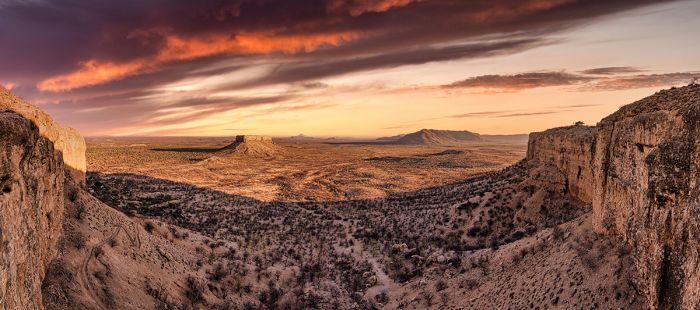
Spectacular vista near Vingerklip in Damaraland, Namibia.
Damaraland
The Damaraland region is a year-round destination with a semi-desert climate. In general, this means very little rainfall, hot days, and chilly to freezing nights. During the summer (when rains are possible), some roads may become muddy and difficult.
May can be spectacular after the rains, with the possibility of greenery and flowers in some places. June thru September are the coolest months, with nighttime temps becoming quite cold. October to December is springtime, with chilly evenings and hot days.
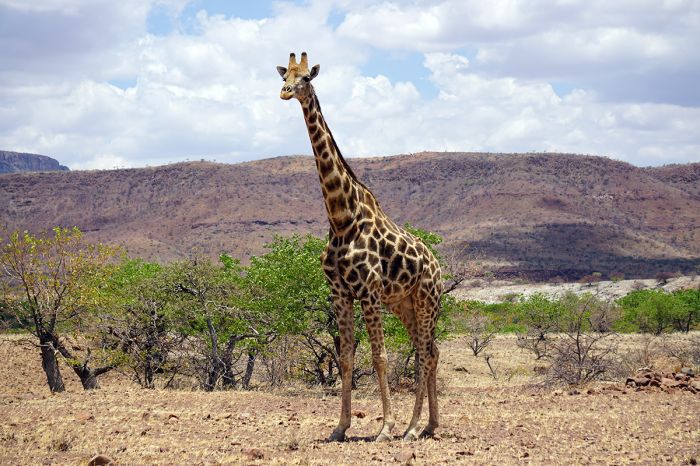
A giraffe in Damaraland, Namibia.
SUMMER
The summer months are November thru April and have the only possibility of rainfall, yet rains are uncommon in this region. Afternoon showers are possible, but unlikely. Morning temperatures average in the low 60s°F (16-17°C) and reach 79-86°F (28-30°C) during the day.
Rains, when they do fall are most common from January to March, but one actually hopes for rain here as it can make your visit spectacularly special. Rain is not a concern for spoiling any portion of a visit to Damaraland.
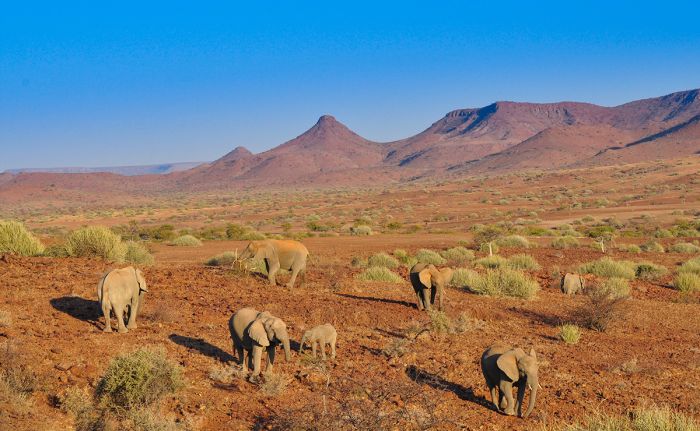
Elephants in Northern Damaraland near Palmwag.
WINTER
May thru October is winter in Damaraland and the climate is extremely dry and somewhat cooler than the summer, especially at night. May thru August are the coolest months with morning temps averaging in the low 50s°F (10-11°C) and reaching the low 70s°F (21-23°C) during the afternoons.
September and October are much warmer and still very dry, with mornings temps in the mid-50s°F (12-13°C) and afternoons in the low 80s°F (26-28°C). October can be extremely hot, with temps often exceeding 100°F (38°C). The first rains usually arrive sometime in early November.
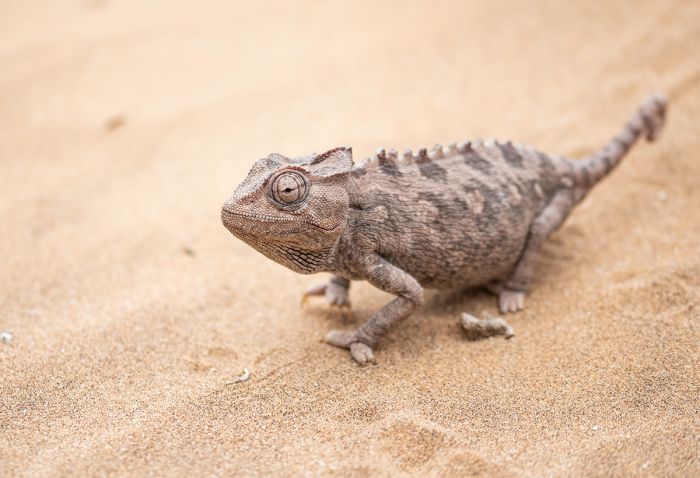
A Namaqua chameleon (Chamaeleo namaquensis) in Damaraland.
Showing 1–3 of 3 results
Located in one of the best wildlife areas in Namibia in a dramatic semi-desert with mountains, ephemeral rivers, rock-strewn plains. Activities include nature drives, walking, cultural visits with local Damara farmers, and a visit to Twyfelfontein.…
Located in a remote and starkly beautiful desert setting and offering the most authentic black rhino tracking in Africa, both on foot and by vehicle under the guidance of Save the Rhino Trust (SRT) monitors.…




